1. INSTRUCTIONAL DESIGN & LESSON PLANNING
Applying concepts from human development and learning theories, the effective educator consistently:
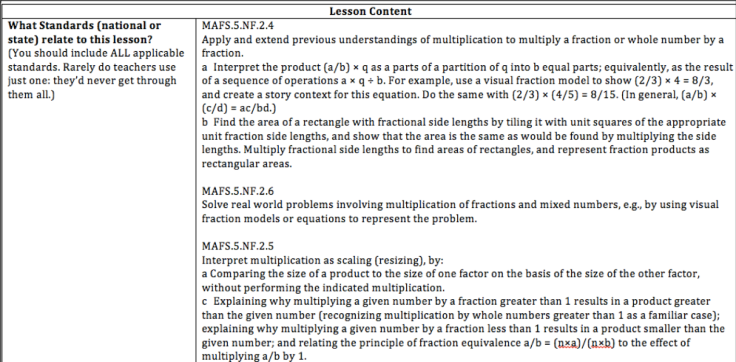
Within this lesson, the students were reviewing for a math test by rotating around the classroom in centers. The students needed to preform and understand all of these standards in order to be successful on their test that was coming up. Through the use of student interest, the centers were created to be engaging and at the appropriate level that the students are expected to be at.

This lesson was geared towards teaching children the shapes and being able to apply their knowledge in the real world. I had the students do a shape hunt outside where they had to draw a picture of what they saw, name the shape, and describe in a sentence the location of the object.
b. Sequences lessons and concepts to ensure coherence and required prior knowledge
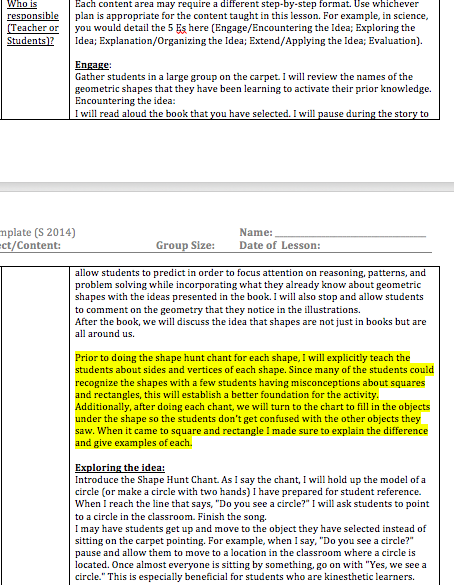
Prior to this lesson, I conducted a pre-assessment to gauge what there prior knowledge about two-dimensional shapes was. Many of the students went to pre-school so they may have more knowledge about shapes than those who did not go. This is important information to gain so that I knew what I needed to explicitly teach and how I needed to enrich the other students that may already know a lot of information about shapes. In this lesson, I used the students’ prior knowledge of recognition of shapes, but struggle of recognizing the difference between a square and a rectangle to reinforce and create a strong foundation of what makes these two shapes different. I touched on it throughout the entire lesson so that they would be exposed to that information more than just once.

Understanding the prior and background knowledge that students need to know is apart of sequencing lessons within a school year. You have to build upon the students prior knowledge and as time goes on that knowledge expands. The lesson that this evidence is from required the students to already know their letter sounds, have blending capabilities, and know sight words in order to write sentences.
c. Designs instruction for students to achieve mastery;
Within this lesson, I had the students sorting shapes in various ways. These ways included 3-d verses 2-d, whether a 3-d shape rolled or stacked, whether a 3-d shape was curved or flat, etc. Prior to doing this sort I had looked at their final assessment that they would be taking after. I wanted to make sure to cover all of the attributes that they would be tested on. I wanted to give them ample enough practice so that they could achieve mastery. Within this practice, I differentiated for each of the levels within my class so that their practice would be beneficial to them and not at a level that was too challenging or too easy.
d. Selects appropriate formative assessments to monitor learning;
Blog Post
This pre-assessment is mainly focused on their ability to recognize a real-world item as a shape and it doesn’t bring any type of literacy into account. I deliberately eliminated the need for writing in this pre-assessment because many students are still having a hard time writing words. I didn’t want to gauge my adjustments mainly on their ability to write, I wanted to know their knowledge of the mathematics topic of shapes. This assessment will show me what shapes the students are familiar with and what they are not familiar with. Since this is going beyond just being able to recognize a drawn shape, it is allowing me to really see if the students see that there are items in the real world that can be defined as shapes. Additionally, since this is what my lesson will be about, it will give me the necessary information to provide any scaffolding that may be necessary. It will also tell me if students already all know a certain shape then instead of focusing on that shape, I can expand upon those shapes such as teach the vertices and sides.

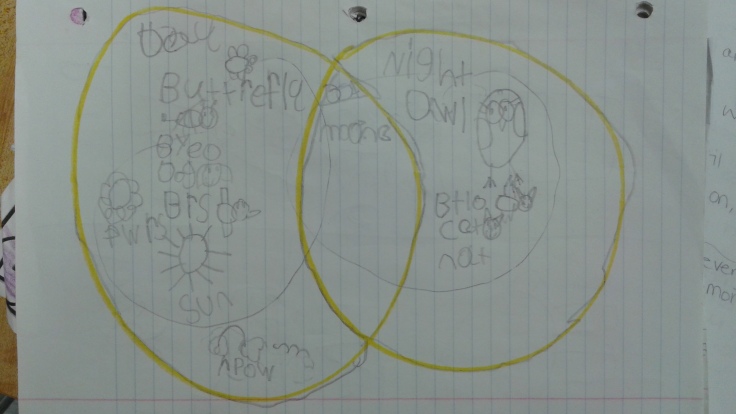
I wanted the students to show their learning through a Venn diagram because they had been writing sentences about day and night the past couple of days.
e. Uses a variety of data, independently, and in collaboration with colleagues, to evaluate learning outcomes, adjust planning and continuously improve the effectiveness of the lessons; and

On October 12, I sat down with the ESE resource teacher to gain information about accommodations for students with disabilities. This meeting provided me with that opportunity to collaborate with colleagues that have more information on a certain subject than I do. Through the collaboration I was able to better meet the needs of the learners within my classroom because I will be able to accommodate the classroom in a much more supportive manner. Additionally, as I was talking with the ESE resource teacher, I realized that there are a lot of strategies I would use for other students as well. I knew that I need to adjust my lessons and my planning with these accommodations. Doing this showed me that there is never an end to learning more information to better the effectiveness of a lesson for all students.
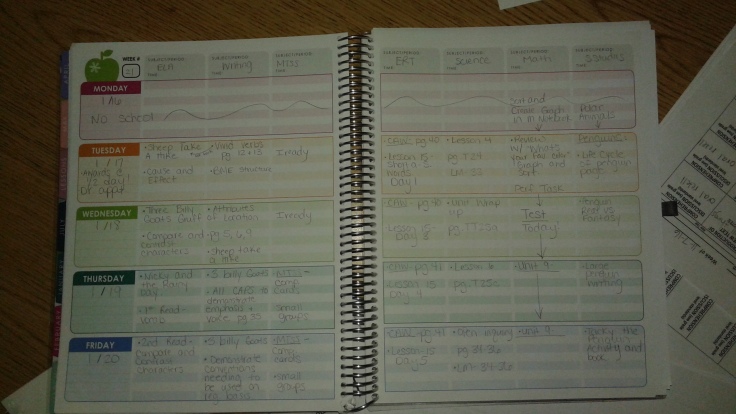
On Mondays my CT and I sit down and plan for the next week’s lessons and activities.
f. Develops learning experiences that require students to demonstrate a variety of applicable skills and competencies.
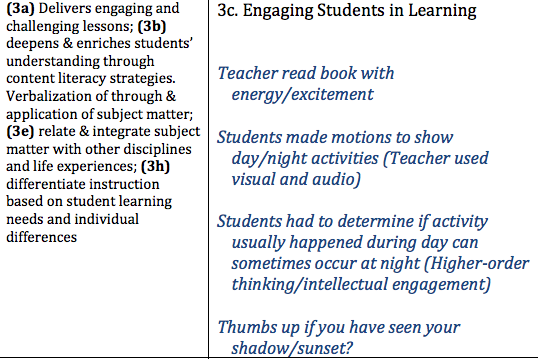
I started the lesson with a read aloud and questions throughout, then I did an interactive activity with them where they showed their understanding through motion, after the activity the students completed a Venn diagram where they could expand their knowledge through comparing and contrasting. The students were able to show their understanding through one of these forms of learning.

For this lesson, my goal was for the students to understand how to properly critique giving appropriately constructive feedback. I taught this by doing an art critique first. Many of my students are interested in art, so I thought using a visual first to represent how to give feedback would support their learning and their ability to give feedback within their peer’s writing. The students were able to demonstrate multiple skills in this lesson because they had to look at a piece of art, analyze and critique it, give feedback, and then be able to apply this knowledge to writing.
2. LEARNING ENVIRONMENT
To maintain a student-centered learning environment that is safe, organized, equitable, flexible, inclusive, and collaborative, the effective educator consistently:
a. Organizes, allocates, and manages the resources of time, space, and attention;

In this class, when students are given the slightest amount of freedom they often get out of control with their noise level. Since I knew that all of the students enjoy when music is playing while they are working, I used that to my advantage in my management. I told the students that while they are working in their stations, there will be music playing in the background. I told them I expected them to keep their noise level low enough so that they and I would be able to hear the music. When the students were in a station and switching stations, I had a timer up on the board that allowed the students to manage their time and work in their station effectively in the time that was given. This would allow students to become responsible for their time, rather than constantly relying on the teacher to inform how much time was left.
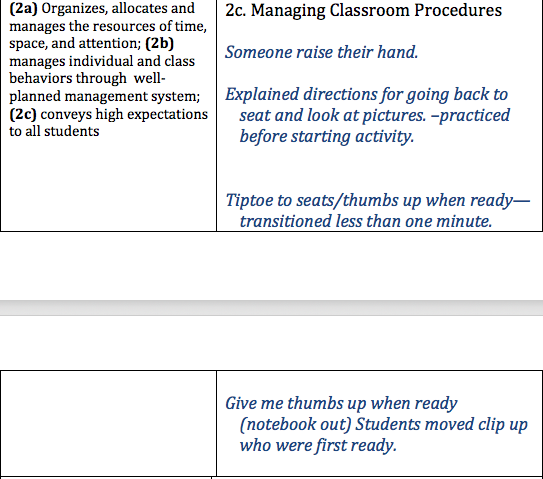
After a lesson my supervisor observed, he left me these notes that describe how I managed the class and organized and allocated my time.
b. Manages individual and class behaviors through a well-planned management system;

During a stations centered lesson, one of the students was getting upset with his group members and became distant with the others and outcasted himself. I decided to take action because this would be no good to him academically or socially. I went up to the group initially and asked why they were arguing, when they began to tell me in more of a “blame game” routine, I thought talking to the student individually would be best. I took him aside and asked him why he was upset. He communicated his unhappiness with being in the group, and I immediately asked if he would work better in another group. His answer was yes and pointed to the group he would work better in. After seeing that he chose the group with the ELL students, I may assume that he works better when he is in the position to help instead of the one being helped.

In this class, there is a very set management system in which the students are familiar with. They know that when I am talking they are not, and if they are then redirecting them looks like me either putting my finger over my mouth, telling them that I will wait, or just reminding them of the expectations. Within the lesson that this feedback is from, I was reading a book aloud and some of the students would get antsy, instead of making a big deal and creating a distraction, I simply said the students name and continued to read. The student knew at that point what they should be doing.
c. Conveys high expectations to all students;
| Evaluation Plan- How will you know students have mastered your objectives?
Address the following: ¨ What formative evidence will you use to document student learning during this lesson? ¨ What summative evidence will you collect, either during this lesson or in upcoming lessons? |
Throughout the story I will ask questions that will provoke higher order thinking and they will be expected to be listening throughout the reading in order to fill out a Venn diagram comparing and contrasting the two stories. |
During my read-aloud lesson, I expected the students to not only pay attention, but I also expected them to be actively listening for details that they could individually add to their Venn Diagram. After reviewing the Venn Diagram worksheets, every single student had written down information within each slot even the ELL and unmotivated students.

Prior to allowing students to transition into the next lesson, I always would give my expectations for what the students should be getting out and what they should do when they get those materials out. Giving the students this task and a way to show the task is completed gave the students a job that they were physically able to finish and feel accomplished and ready to start. Before releasing the students to do this, I would ask them what they should be doing and what was expected of them so that they would know for sure what they need to do.
d. Respects students’ cultural, linguistic and family background;
| If applicable, how does this lesson connect to the interests and cultural backgrounds of your students?
Students can bring in their prior/background knowledge of their cultural background into learning about the way that communities work and things that communities contain. -JC has lived and seen multiple countries and seen the different communities and how they work that she can add to the lesson (FN 6/7/16). -DE has been to Ireland because he’s Irish and can share how their community is (FN 6/7/16). -CA and BB enjoy playing video games (FN 6/7/16), and the incorporation of iPods play into that. -DE said he liked Nike related items (shoes) and one of the rights and responsibility cards during the game is going to be based on the company Nike (FN 6/7/16) -BB, JC, and MD like being active and with a group (FN 6/7/16) -MD enjoys having the opportunity to share her thoughts (FN 6/7/16) -All children live in the Seffner/Brandon community that they can all relate to each other. -Through the ability to share from their own specific lives and communities they are able to incorporate their interests. -For the students that enjoy expressing their thoughts through drawing they will be able to draw their emotion instead of just circle an emoji (JC, CA, and MD) (FN 5/31/16) -BB likes to bring things in from home and talk about it, he could bring in his football jersey and talk about how his football team influences the community. (FN 6/7/16) Writing Instruction: -The students will draw a map, label, and explain in a short paragraph about their community. The map with be a drawing of their surrounding area and the paragraph will be about how everything is connected and flows within the map they drew. This gives students who enjoy expressing themselves through art and those who may not favor art, a chance to be successful.
|
Within this lesson I incorporated the students ability to connect and discuss their own heritage and the different communities they have seen as they’ve grown up to help understand and learn about how businesses work in a community and how everything works together in a community for it to work efficiently. The students are also able to use their culture when bringing in items that represent their community.

When teaching, it’s important to remember who you are conveying information to. You aren’t blindly giving information to a mindless object. The students that you are teaching have a voice and a view on things as well, and apart of teaching is giving them a voice within your class. In this lesson, I gave the students multiple opportunities to join in on the discussion of the lesson’s topic. This is all apart of respecting students because if you don’t respect their views and opinions how do you expect them to respect yours.
e. Models clear, acceptable oral and written communication skills;


f. Maintains a climate of openness, inquiry, fairness and support;
Blog Post
“When I came to Luna and Susan’s group, they were experiencing difficulty with their coaster. The marble keep stopping before going around the tear drop loop, since they should be in-between Piaget’s Concrete and Formal Operational Stages, I questioned them asking: “why do you think this is happening?” (FEAP 3F) Luna’s logical response clearly showed an understanding for abstract reasoning because she said: “the marble doesn’t gain enough kinetic energy before entering the loop.” She then hypothesized a change of design, theorizing to place the loop closer to the initial drop. Susan, on the other hand, was preoccupied with the fact that she might loose her teacher directed P.E. because they were having to redesign their roller coaster. I reaffirmed them that if it came to that, then I would stay in the class with them while their working. Luna proclaimed right away, “that sounds like a deal!” I told them that I would check back in with them so I could see what the other groups were doing (FEAP 2f).”
I believe that this example exemplifies the FEAP 2f because it shows that I supported these students as they were developing their projects. Also pushed these students to think deeper and actually inquire about their own theories as well. I showed them that I am here to help them and that if they didn’t finish during the time allotted then I would stay back with them until they did finish.

Being open to allowing the students to “add something” to the lesson, enables the students to feel competent in themselves and their abilities. This openness provides students with the social support that is needed within kindergarten.
g. Integrates current information and communication technologies;

During this lesson, the students were using iPods to scan QR codes in order to complete their discussions. They were utilizing the technology in order to learn and communicate the required information in the lesson. The lesson was about the community and how everything works within it, which is essential content that students should understand as a citizen.
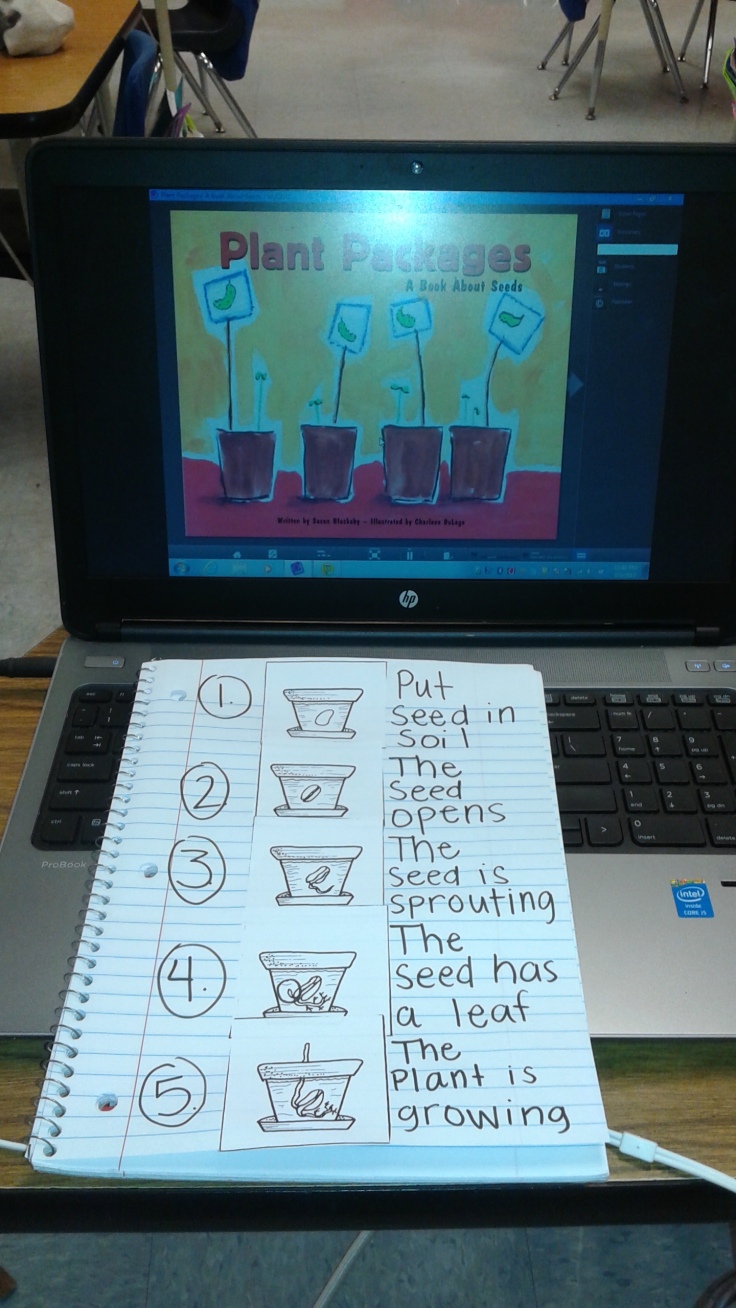
In this lesson the student listened to a Myon book, and throughout the book I would ask questions to engage their thinking so that they would be actively listening and participating. After learning about plants and how they start as seeds, the students did an activity that required them to use their reasoning skills in order to determine the order of how a seed looks throughout its life.
h. Adapts the learning environment to accommodate the differing needs and diversity of students; and
| How will you differentiate instruction for students who need additional challenge during this lesson (enrichment)?
The students will have the choice to work with a partner or a small group, so they will be able to ask their peers questions and learn through each others questions. The students that may need additional challenging will be given a larger body or a group of communities and how they interact and influence each other. Another option is for students to think about the Divergent series and the factions within the book. They will discuss how the right and responsibility is seen within the factions. They will also discuss how the community described within the factions are similar and different than their own and what they entail. Since MD is in the gifted program, I will have this enrichment opportunity for her in order to engage her higher order thinking ability. |
| How will you differentiate instruction for students who need additional language support?
The video will allow ELL students to better understand what this lesson is all about. The game allows students to find a match through symbols not just through words, thus allowing ELL student to match symbols first then understand the content that is being matched. In the game the students are finding a match, there are symbols on the cards that will aid students who are struggling with both trying to find a match and reading the cards. -connect to the student’s own ideas about the community, where ever they may be from. -JC is in the final stage of the ESOL program so she may need additional support when talking about certain vocabulary terms. I will provide a set of vocabulary terms that we will be talking about during the lesson on the word wall with their definition. |
| If applicable, how does this lesson connect to the interests and cultural backgrounds of your students?
Students can bring in their prior/background knowledge of their cultural background into learning about the way that communities work and things that communities contain. -JC has lived and seen multiple countries and seen the different communities and how they work that she can add to the lesson (FN 6/7/16). -DE has been to Ireland because he’s Irish and can share how their community is (FN 6/7/16). -CA and BB enjoy playing video games (FN 6/7/16), and the incorporation of iPods play into that. -DE said he liked Nike related items (shoes) and one of the rights and responsibility cards during the game is going to be based on the company Nike (FN 6/7/16) -BB, JC, and MD like being active and with a group (FN 6/7/16) -MD enjoys having the opportunity to share her thoughts (FN 6/7/16) -All children live in the Seffner/Brandon community that they can all relate to each other. -Through the ability to share from their own specific lives and communities they are able to incorporate their interests. -For the students that enjoy expressing their thoughts through drawing they will be able to draw their emotion instead of just circle an emoji (JC, CA, and MD) (FN 5/31/16) -BB likes to bring things in from home and talk about it, he could bring in his football jersey and talk about how his football team influences the community. (FN 6/7/16) Writing Instruction: -The students will draw a map, label, and explain in a short paragraph about their community. The map with be a drawing of their surrounding area and the paragraph will be about how everything is connected and flows within the map they drew. This gives students who enjoy expressing themselves through art and those who may not favor art, a chance to be successful.
|
Each of these parts of a lesson show how I accommodated for either specific students or for a larger quantity of students. There are many students within a classroom, and each individual student might need a more unique route to go through as they learn. There are accommodations for ELL students, students that need to be enriched and then accommodations made according to student interest and their cultural background. This enables the students to be able to better attain success when understanding about how the community works and how things are connected because they are able to draw from their own experiences, and they will be able to have a readiness level appropriate for their learning.

This year I differentiated the practice activities that the students did according to what I saw they needed to work on. In this class there are a lot of different leveled students, so I thought it would be appropriate to strengthen the needs that each child needed through the use of three different activities. This shows professional growth because I have been able to use information about my students to actually plan and implement in the classroom. The previous piece of evidence was just the planning portion of a lesson plan.
i. Utilizes current and emerging assistive technologies that enable students to participate in high-quality communication interactions and achieve their educational goals.

Although iPods have been out for a while, within schools and the classroom they are still an emerging assistive technology. The students within this lesson used the iPods in order to discuss what they saw in the video. They scanned QR codes instead of just reading prompts in order to increase their engagement and achieve a higher-quality of communication between the students. They used these QR codes to discuss and meet the standards that were desired outcomes from this lesson.
3. INSTRUCTIONAL DELIVERY & FACILITATION
The effective educator consistently utilizes a deep and comprehensive knowledge of the subject taught to:
a. Deliver engaging and challenging lessons;

During a math review lesson, I thought that instead of having the students just practice independently, doing different tasks to review at four centers would be much more enjoyable and engaging. Each center’s task was turned into a game that the students were engaged in throughout the time restraint. One of the centers had riddles (word problems) that I made to relate to the students interest (sports, sponge bob, food, etc.) that were similar to what they were going to see on the test. The centers were enjoyable for the students and challenging as well. One of the students even wrote on their exit ticket that the pictionary station actually helped him understand how to visually represent fractions being multiplied.
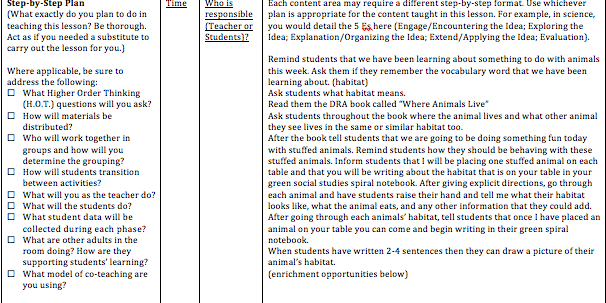
Students had to use their knowledge that they learned about habitats to write about the stuffed animal they were given. The habitat writing had to include their shelter, food, surroundings, etc.
b. Deepen and enrich students’ understanding through content area literacy strategies, verbalization of thought, and application of the subject matter;
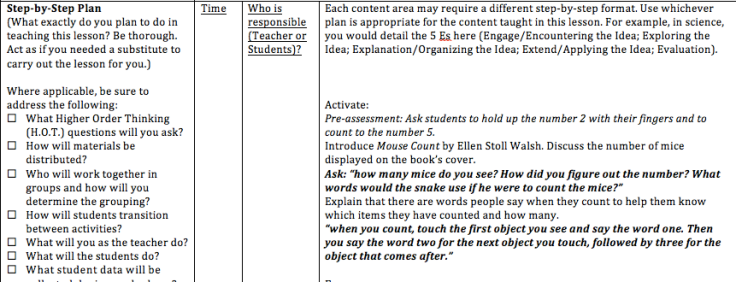
In this lesson, I used a children’s book to gain their attention and teach the math concept. The lesson is geared towards kindergartener’s, therefore it is appropriate to use literacy in as many content areas as possible because these students are still learning how to read. Additionally, they are able to see that literacy isn’t just found in the reading and language arts portion of their day, but in every subject area. While I was reading to the students, I asked prediction and inference questions to begin guiding their minds as to what they should be thinking while they are reading.

In this guided reading lesson, I had the students use comprehension strategies during their reading.
c. Identify gaps in students’ subject matter knowledge;


Prior to teaching this lesson, I had the students hold up two fingers and then count on from that point with their hands. Because many of these students are still learning how to write, I thought that it would be most appropriate to pre-assess in this way in order to truly see the gap in students knowledge. This allowed me to them decide which students should do which practice activities in order to strengthen the skills that they need to strengthen. Prior to this lesson, I had used a pre-assessment before, but it was more as a self reflection than anything else. I had the students write about what it would be like without skin, and then they answered the question again after the lesson on the same paper. This year I actually used the pre-assessment in order to identify the gap and within the same lesson provide students with the support they needed.

In order to understand where student’s may have gaps in their learning, you need to identify the background knowledge that is required in the lesson that you are about to teach. With this information, you will be able to determine which students will need more support because of the gap in knowledge.
d. Modify instruction to respond to preconceptions or misconceptions;

This assessment will show me what shapes the students are familiar with and what they are not familiar with. Since this is going beyond just being able to recognize a drawn shape, it is allowing me to really see if the students see that there are items in the real world that can be defined as shapes. Additionally, since this is what my lesson will be about, it will give me the necessary information to provide any scaffolding that may be necessary. It will also tell me if students already all know a certain shape then instead of focusing on that shape, I can expand upon those shapes such as teach the vertices and sides. This is one of the adjustments that I made to my first day lesson. I taught the students about the sides and vertices of each shape which gave them a firm foundational understanding of the shapes. Additionally, I made sure to go over the differences between squares and rectangles during this time.

With this lesson, I knew that there was a weak understanding of the difference between a square and a rectangle. I knew that the students were able to recognize and match objects with their shapes, therefore I increased the difficulty level to where I would teach the students the number of sides and vertices.
e. Relate and integrate the subject matter with other disciplines and life experiences;

The book that I chose for this guided reading lesson was about a conflict that the characters had while playing hide and seek. The students were able to apply and integrate what they knew about playing this game and facing issues like what were in the book to comprehend what was going on. The grade of the students are kindergarten so this life experience is appropriate to build a lesson around because of their age.
Within this read-aloud, the topic was adaptions that animals do to survive. This was primarily an ELA lesson to teach the students about the main idea and details within the text. I was teaching the students to be able to use the text when given a question to answer. However this lesson included content that was science related, which also is related to their field trip that they would be going on within the following week to the zoo.
f. Employ higher-order questioning techniques;

Within this lesson, I knew that many of the students may already have knowledge about the community and how it worked, therefore, I wanted to employ many higher-order questions that would engage the students into thinking more deeply about the content. Additionally, since this lesson was an introduction to the curriculum, I really wanted to get the students thinking about preparing them to think in different ways. I implemented these higher-order questions in a small group discussion setting so that the students would be able to feel more comfortable to discuss and communicate their thoughts. Through these higher order question discussions many of the students were able to learn new information and perspectives that their peers shared broadening their knowledge. Since the lesson was about the community, I thought that using real-world question opportunities would give all students the ability to share their thoughts rather than a textbook question they might not be familiar with.
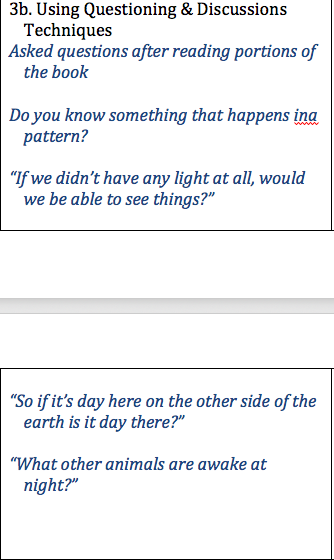
During this lesson, my supervisor listed some of the questions that he heard while I was teaching. There is a variety of leveled questions that were asked within this lesson about day and night.
g. Apply varied instructional strategies and resources, including appropriate technology, to provide comprehensible instruction, and to teach for student understanding;
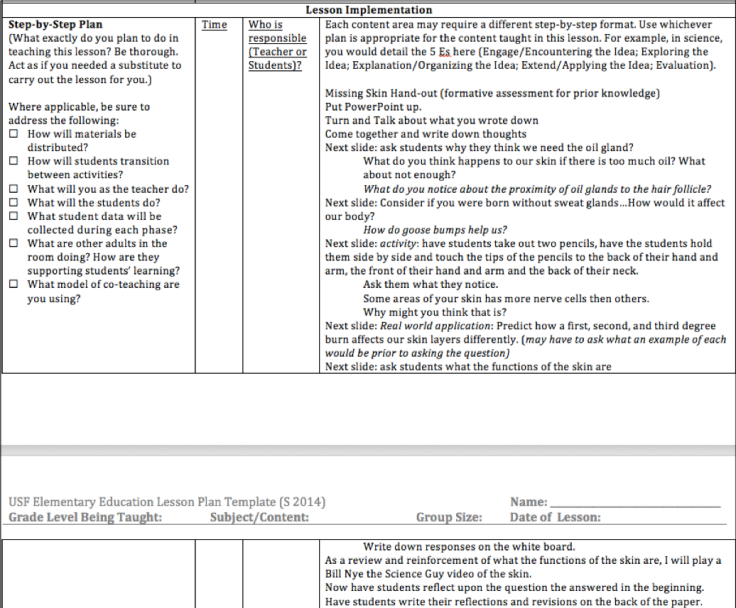
In my science lesson on the skin I incorporated a multimodal representation to display the notes and questions for the students. This allowed for some of the visual learners to actually see images about what I’m saying that would reinforce their learning based on their learning style. Additionally, after going over the functions of the skin on the Powerpoint, I had the students watch a Bill Nye video. I allowed the students to come and sit on the carpet if they wanted too to watch the video.

Throughout this semester, I have used myon books a lot to support student learning. Myon is a great instructional tool that provides a voice other than the teachers’ to read a book. Sometimes students need that change in vocals throughout the day. Additionally, that integration of technology provides that interest that captivates the students attention.
h. Differentiate instruction based on an assessment of student learning needs and recognition of individual differences in students;

My teacher had an RTI group that needed assistance with reading comprehension. She suggested that I focus on a reading comprehension strategy, so I focused on inferencing because as I observed the students the previous week, they were having difficulty with inferring. Before doing my lesson, I talked to the other teachers of the students to ask about their learning, IEPs, and any additional information that could be necessary for accommodations. My lesson reviewed what inferencing was (since they should have learned about prior to now) and then I played a game/activity with them that required the students to read a situation and make an inference based on that situation.

This lesson was a guided reading lesson for my above level students. Guided reading groups are purposely differentiated based on the students’ level in order to expand their reading skills and knowledge.
i. Utilize student feedback to monitor instructional needs and to adjust instruction.
This formative exit ticket allowed the students to express their feelings towards the lesson and the strategies that I used. It not only allowed them to visually represent their feelings but it also gave them a voice to explain why they felt that way. This allowed me to make changes towards my teaching the next time I used those strategies.
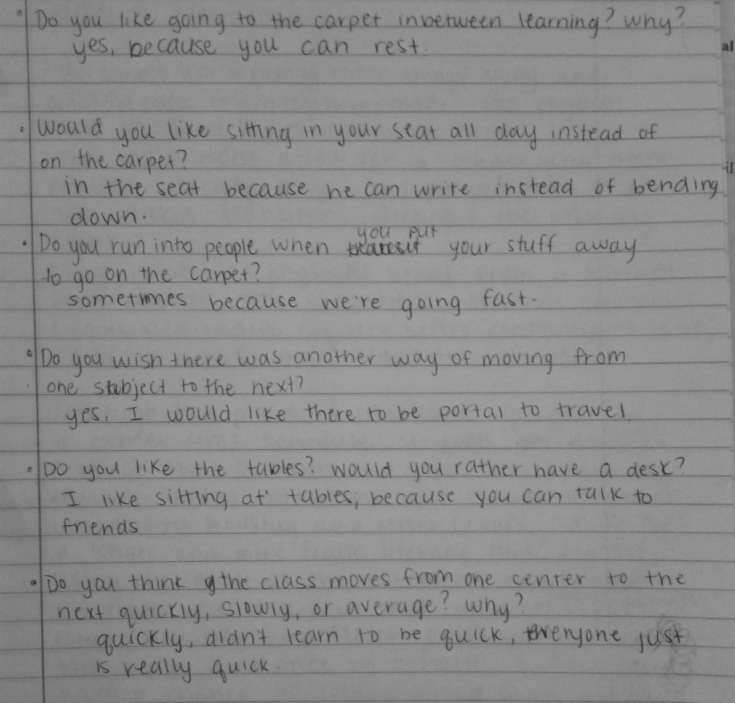
This year I have been taking part in an inquiry that required the students to provide feedback. This feedback allowed me to adjust my actions that I made in order to provide the students with the optimal environment to thrive in academically.
4. ASSESSMENT
The effective educator consistently:
a. Analyzes and applies data from multiple assessments and measure to diagnose students’ learning needs, informs instruction based on those needs, and drives the learning process;
Blog Post
The first pre-assessment I am going to have the students do is a matching worksheet. This will have various real world items pictured and I will have the students sort them in their proper shapes.This assessment will show me what shapes the students are familiar with and what they are not familiar with. Since this is going beyond just being able to recognize a drawn shape, it is allowing me to really see if the students see that there are items in the real world that can be defined as shapes. Additionally, since this is what my lesson will be about, it will give me the necessary information to provide any scaffolding that may be necessary.
The assessment I chose to use after my day one lesson is the exact one that they would be using other shape hunt. I chose this as the formative assessment so that I would be able to see who was competent in the assessment and needed enrichment the next day and who would need extra support with a partner the next day as well. Additionally, I would be able to see if I needed to make changes to the assessment during the shape hunt.
The final assessment was in the form of a chart with a space for the students to draw an image of the object and also has a sentence starter for them to be able to write the word of the object they drew. Each of these assessments was able to show me learning gains made by the students.
b. Designs and aligns formative and summative assessments that match learning objectives and lead to mastery;

Since kindergarteners are still learning how to write, it is appropriate to gauge their learning through the use of images. The objective for this lesson was for the students to identify the tools that community helps use. Because this lesson was based on discovery learning, the students were learning by viewing a book and being able to recognize what items their community helper was using in the images. When I had the students come up to help the class, I was able to see the students mastery of the lesson because they were able to tell me what images to draw for the tools that their community helper had.
In this lesson, the students were focusing on identifying the beginning, middle, and end events within a story. The assessment that I chose allowed the students to practice this skill and also their writing skills.
c. Uses a variety of assessment tools to monitor student progress, achievement and learning gains;
Throughout my internship this semester, I have used a variety of assessments to see my students’ learning. I believe that there is no “one size fits all” assessment, thus I think that the assessments that are used should give every student a chance. It shouldn’t be the same type of assessment every time, otherwise some students’ mastery may not be clearly shown. This is only a select few of the assessments that I have used this semester.
d. Modifies assessments and testing conditions to accommodate learning styles and varying levels of knowledge;
These documents display the modifications to an assessment that I made for my students based on their ability level and varying levels of knowledge. This allowed them to find success in this lesson.
“To explain the assessment specifically, this is where my differentiation for my variety of learners came into play. This includes students who display their knowledge better by writing, or drawing, or acting out. For ELL students who needed support with language they could have drawn a picture or acted out one of the animal adaptions. After the students were supported with their assessment choice, we all shared what we said so that we could view how each of us learned. The differentiation for the assessment gave the students 3 choices, they could either write two sentences about one of the animals and how it adapts, draw a picture and label an animal adapting to its surrounds, or write what down what animal and its adaption they were going to act out for the class. I will definitely be incorporating these options in my future classroom, because all of the students were then able to feel confident about how they displayed their knowledge.”
In this lesson I provided students with three different options for their assessment choice. The three choices allowed students to pick which one they would be able to show their mastery knowledge through the best.
e. Shares the importance and outcomes of student assessment data with the student and the student’s parent/caregiver(s); and
These two images are from the APTT conference that my school decided to hold. During this conference the parents of the students go into their students’ class and the teacher explains where their student is according to the other students in the class. Within the folders it also contains more specific information for their student, such as their knowledge of sight words and addition. After viewing all of this information the parents make a “S.M.A.R.T.” goal for their student. This shows parents what they need to work on with their child. The data chart that allows the parents to see where their child is provides that guidance of why making a goal is so important.
After a parent teacher conference, my CT and I have been keeping one of our student’s parents updated on their sight words. Once the parent realized that the columns symbolized quarters within the year, she realized just how far behind he was. Now with the understanding that he needs the extra practice at home, we test his sight word recognition every Friday and send a copy home of the updated sheet. This allows his parent to keep up to date on which sight words he has to work on.
f. Applies technology to organize and integrate assessment information.
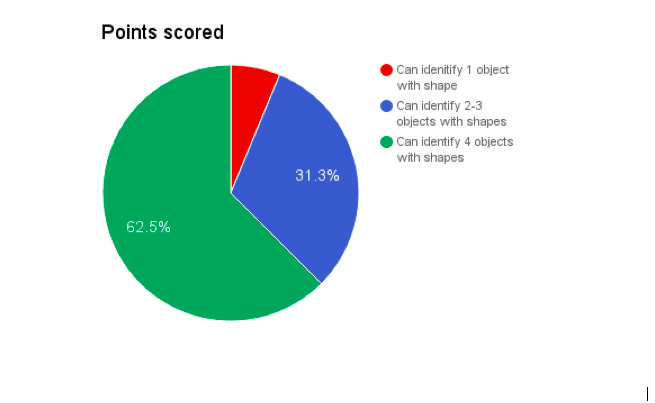
This pie chart illustrates the number of students that were able to identify the four shapes that we focused on in real world objects. All of the students were able to identify at least one object that was a certain shape. This chart allows me to see the percentage of students within the class that understood and meet standards. There were sixteen students that I was able to gather data from, and from looking at the chart ten out of those sixteen students were able to identify all four shapes. That 62.5% shows that the majority of the class was able to show mastery in this lesson after the second day of lessons. Although 62.5% is a relatively low number of students to show mastery, every student did attempt the assessment. While I was reviewing the assessments, I only counted a shape as being identified if I was clearly able to visualize what they were drawing. Since their sensor motor skills are still developing, the percentage of mastery could be skewed, so as I move forward into the other shapes, I will still give students opportunities to view the prior shapes with the new shapes.
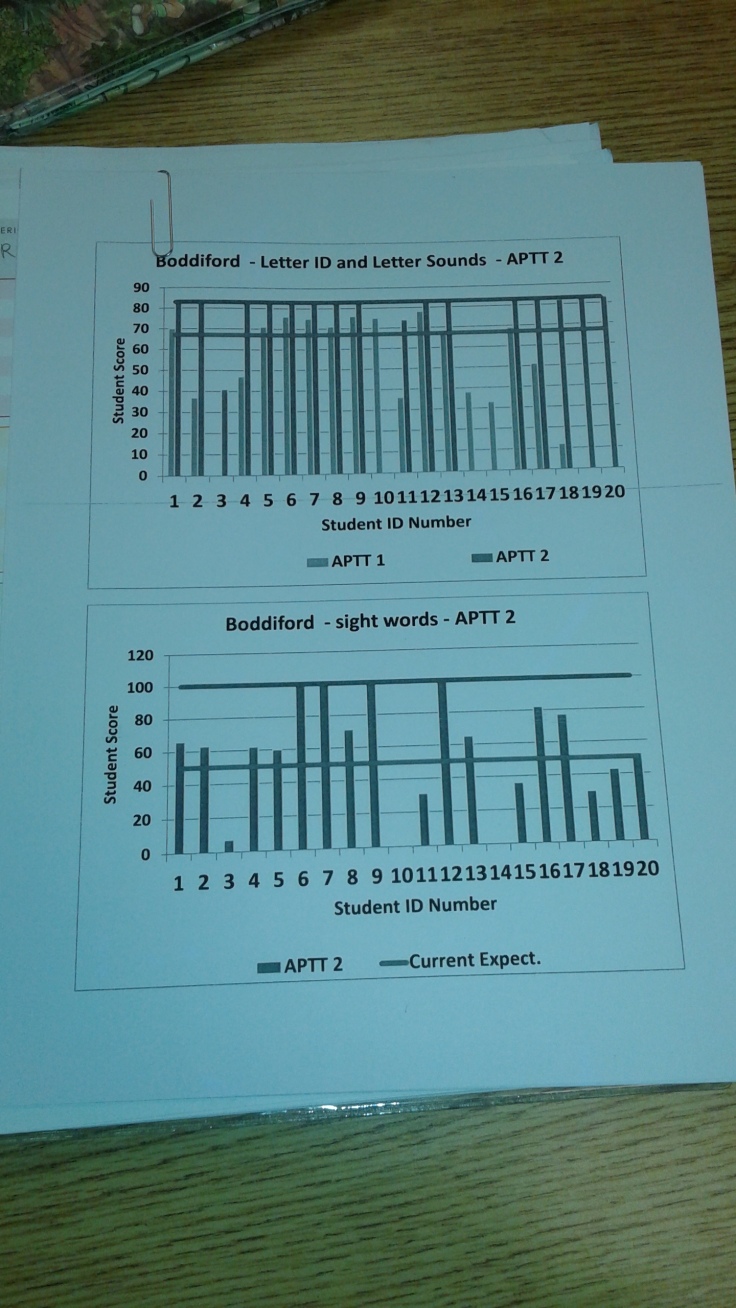
For one of the conferences, the structure of it required for the student data to be displayed through a data chart made on the computer. The first horizontal line shows where the students should be at and the vertical lines show where each student tested at. The second horizontal line displays where students should be at the end of the year.
5. CONTINUOUS PROFESSIONAL IMPROVEMENT
The effective educator consistently:
a. Designs purposeful professional goals to strengthen the effectiveness of instruction based on students’ needs;
Mid-Semester Goal Blog Post
“It’s not a simple task and I am learning about the various ways and strategies that can be implemented to increase the engagement in the classroom. Last semester I would make a lesson and think that it was really engaging, however, I would find that the students weren’t very engaged during the lesson. I wanted to focus on how to differentiate because it is so crucial in being an effective teacher and also because it is the focus of my inquiry.”
Blog Post
“As the art critique on Vincent Van Gogh’s “Starry Night” began I soon unrevealed a true passion in my below level student. His level of critique input was at an extremely high level and far past that of a fifth grader.”
After discussing the students involvement and engagement with the art teacher in her class, I found that one of my below level students in Language Arts had high engagement and motivation in her class. When I found this out, I made the decision to incorporate art into a lesson where the students were learning how to articulate positive and appropriate critiques. In order to do this, I had the students look at a painting and answer the three prompts: something they like, a question they have about it, and a suggestion or something they would do differently. The piece of art created an atmosphere that supported my below levels interests and strengths that enabled him to fully understand and succeed the overarching content they were learning.
b. Examines and uses data-informed research to improve instruction and student achievement;
| Yarbrough, J. L., Skinner, C. H., Lee, Y. J., & Lemmons, C. (2004). Decreasing Transition Times in a Second Grade Classroom. Journal of Applied School Psychology, 20(2), 85-107.
This article discussed how the transition times of various classrooms were effected when using certain strategies. One of the strategies that was suggested by Van Houten and Thompson, was to set a set limit or time students. They had hypothesized that it would be an increase in academic task time because there would be less time spent on the transition. According to Yarbourh, Skinner, Lee, and Lemmons “studies have shown that explicit timing procedures are effective across students, target behaviors, and setting” (2004). Their results depict that when giving these explicating time constrains the classroom management is effected positively in more than just one way. Their study also showed that there was a direct correlation in their direct instruction, timing strategy implementation and the reduction of transition time. Cameron, C. E., Connor, C. M., & Morrison, F. J. (2005). Effects of variation in teacher organization on classroom functioning. Journal of School Psychology, 43(1), 61-85. The authors within this article articulated an approach to view how effective transitions can impact a classroom. Prior to their study, their research indicated that “intensive use of time and effective management related positively with cognitive demands” (Cameron, Connor, & Morrison, 2005). Their background research suggests that when the better the transition system, the better the learning within the classroom because they have more time to spend on academic activities. Additionally, they found that students have a better sense of control and autonomy when there was an organized procedure for transitions. As the depicted in the article, children in primary grades need a considerable amount of instruction and guidance when implementing appropriate transition behaviors. Through their study, they found that when a management system is well organized, articulated, and thought out, then there is a positive effect in the classroom. Sainato, D. M. (1990, November). Classroom transitions: Organizing environments to promote independent performance in preschool children with disabilities. Education and Treatment of Children, 13(4), organizing caregiving environments for young children with handicaps, 288-297. Retrieved November 8, 2016. In the beginning of “Classroom Transitions: Organizing Environments to Promote Independent Performance in Preschool Children with Disabilities” the author defines what transitions are as “a teacher initiated directive to students to end one activity and to start another” (Sainato, 1990). Understanding what transitions are implemented allowed Sainato to study what can be done to enhance a classroom. According to Sainato, organizing the classroom environment to facilitate smooth transitions “minimize the amount of nonproductive time” (1990). The notion that having a “switching activity” was tested during the study to see the effectiveness. A “switching activity” involves having a student do something before going on to the next activity. Sainato saw that there was a correlation to a decrease in time spent when this switching management approach was used. |
Transitions within the classroom play a major role in how students learn. The time that students have to learn is dependent on the time spent during transitions. The transition management system that a teacher has set into place will depict the students’ behavior during the off time. If the students’ behavior is not correlative with the teacher’s expectations, then a lot of the time will be spent managing the behavior rather than transitioning smoothly into the next lesson. Additionally, when students have the chance to have a space of their own, they are able to put unnecessary items within it. These unnecessary items can get in the way of other supplies, thus inhibiting the time it takes to get the appropriate items out during transitions.
Inquiry Blog Post 3
This blog post and these images explains how my Critical Friends Group (CFG) allowed me to improve my instruction and focus as a teacher researcher.
c. Collaborates with the home, school and larger communities to foster communication and to support student learning and continuous improvement;
Everyday this semester, I write in the students’ agendas what color they were on. This allows the parents to visually see how their children were in school and provides a constant form of communication.

One of my students has been struggling with his sight words. Since the parent is really involved with their child’s academic success we have a system of sending home an updated sight word list every Friday. This allows the parent to see what words the child was able to recognize that week and which ones they need to work on them with.
d. Engages in targeted professional growth opportunities and reflective practices, both independently and in collaboration with colleagues; and
inquiry-presentation
My first year within the education program, I conducted an inquiry based on how I could use student interest with their learning. Through this inquiry I researched literature to find strategies that would be beneficial for my wondering. I found a couple of strategies that served to be effective such as incorporating art into lessons, engaging in group or collaborative activities, and a strategy called interest journals. These interest journals became the key to my inquiry because they increase my uninterested student’s writing dramatically. In order to implement these interest journals I had to brainstorm with the students topics of their choosing that they would like to write about. When there was a large enough list, I created a journal for each topic. Each week the students would pick one of the journals and write for 30 minutes. This strategy is something that I will be bringing into my future classroom.
e. Implements knowledge and skills learned in professional development in the teaching and learning process.
Blog Post
What connections can you make to your lesson today from your coursework, the
literature, and any previous lessons or experiences?
I think that since this lesson was purely a differentiated lesson for my enrichment students, I could really see the connection to my planning course that focused on differentiation and how to do it effectively. There are three different things that you can focus on to differentiate for: readiness level, learning profile, and interest. You can also differentiate the material in the lesson such as: the product, content, process, and the learning environment (Tomlinson, 2001). In this lesson I differentiated the readiness level and the content specifically. I did small differentiations with the other categories, but I think you can clearly see the differentiation of the readiness level and the content in my lesson. The students were in need of enrichment (readiness level) so I was able to expand their knowledge than what is normally given to them in reading instruction for whole group. I was able to give them more critical thinking questions that required them to think in a higher manner to answer the questions of why something might be happening. Additionally, the other students in my class aren’t exactly ready to write summary sentences like these students do on their own. I differentiated their instruction in this by allowing them to come up with summaries without my assistance. You can see that I differentiated the content of their instruction by providing a book that is appropriate for their reading level. In order for them to be fully challenged during small group, they needed a text that isn’t too easy for them. I am there to push them so that they may reach their fullest potential in their comprehension and fluency of reading. The book that I chose gave them that challenge that they need.
Another connection that I was able to make in my lesson was to my Emergent Literacy class. In this class we learned about the Daily 5 and the structure of it. During this routine, the students rotate in centers while the teacher works in small groups. My CT has this learning structure taking place when she does small group. It allows the students to be self sufficient and engaging in quality learning rather than just doing busy work while the teacher works with the small group. I also was able to use what I learned about where students’ knowledge in the emergent reading level is at to support and push my students to the next level of the reading stage. These students that I worked with are beyond emergent readers whereas most of the other students are still in the ending stage of this level. Since these students are in the early readers stage, I was able to use what I learned about this stage to support my understanding of what I needed to work on with these students. In this stage the students are able to predict words on their own by using strategies such as sounding out. Emergent readers still need the assistance of a teacher to predict words. So when there would be a word that this enrichment group didn’t know I would challenge them by having them go letter by letter and sound out the word. This would allow them to use the strategy of blending the word themselves (Bear, Invernizzi, Templeton, & Johnston, 2008).
Blog Post
There was a student who did well in this lesson with completing the Venn diagram and doing the recognition activity. This student had been struggling with writing her letters together when it’s one word and using spaces between words. You could clearly see her words in the Venn diagram, along with pictures that she drew of them. For differentiation for my struggling students, I used the strategy and lesson structure that my CT and I normally do for writing practice. We normally switch off supporting these students by pulling them back in a small group. Since I was teaching the lesson, she pulled some back and gave them support while completing the Venn diagram. The accommodations I gave for my ELL students was the use of the picture/audio activity. This gave the students the ability to show their knowledge through motion rather than words. According to Edwards, McLaren, Mckeever, Ruddick, and Zabjek “Recent cognitive neuroscientific evidence indicates that movement and gesture are also necessary for optimal cognitive and communicative development” (2011). This is an important piece of literature to remember when teaching kindergarten because they are such young learners and need that movement. Additionally, before the students independently made the Venn diagrams, I modeled how to fill in the graphic organizer appropriately. While modeling the Venn diagram, I drew pictures of the words and sounded out the words as I wrote the letters.
6. PROFESSIONAL RESPONSIBILITY & ETHICAL CONDUCT
Understanding that educators are held to a high moral standard in a community, the effective educator adheres to the Code of Ethics and the Principles of Professional Conduct of the Education Profession of Florida, pursuant to State Board of Education Rules 6B-1.001 and 6B-1.006, F.A.C, and fulfills the expected obligations to students, the public and the education profession.
In order to be an educator, you have to value ethics and professionalism. During my first semester interning, I have come to see the significance of the these values. Without these things a teacher can quickly loose their passion, their respect, and even their job. As a teacher, we are held on a higher standard than the average joe. Many people might find this to be bothersome, but I find it to be a blessing and a privilege. My passion isn’t just to teach children material for the year, my passion–and I think it should be every teacher’s passion–is to display that there is so much more to education that just the material on a standardized test. Teachers are teaching their students values, ethics, what’s right and wrong, responsibility, respect, right choices, and what being professional is. You see, if teachers themselves aren’t displaying professional responsibility and ethical conduct than the students that are in their class are going to grow up possibly not knowing what it means to be professional, responsible, or ethical. These things are what makes a teacher stand out from the rest of any other career, and I find that amazing. The are essentially only teaching for the sake of a standardized test. Modeling these qualities is one of the best way to teach students how to be professional and ethical. Knowing how to act and behave in a classroom clearly reflects in a teacher’s pedagogy and their students achievement outcomes. Additionally, if a teacher isn’t professional with their students than what are they other than their friend? Most of the time kids don’t listen to their friends teach them something, so essentially if a teacher isn’t professional then their students will disregard the material that is being presented. Having these qualities aren’t just an extra benefit for a person who is desiring to teach, it’s a necessity.
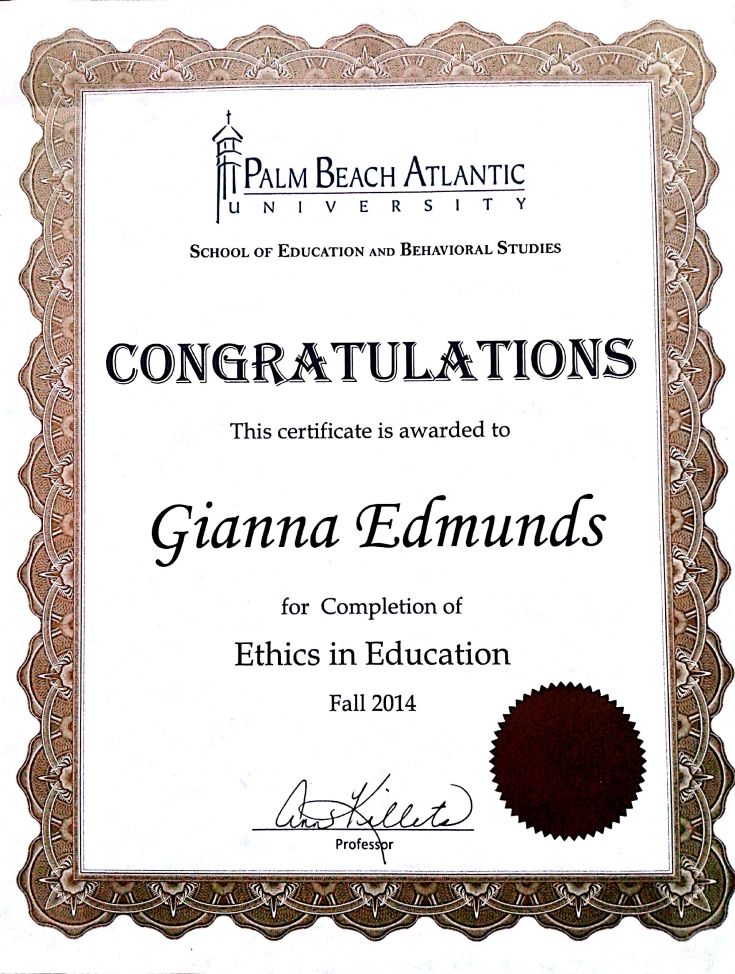
As a transfer student, I was had the privilege of actually studying the ethics within the Florida State Education system. We were then required to take an exam on these ethical rules. Since I passed the exam, my professor awarded me with a certificate of completion.








Recent Comments